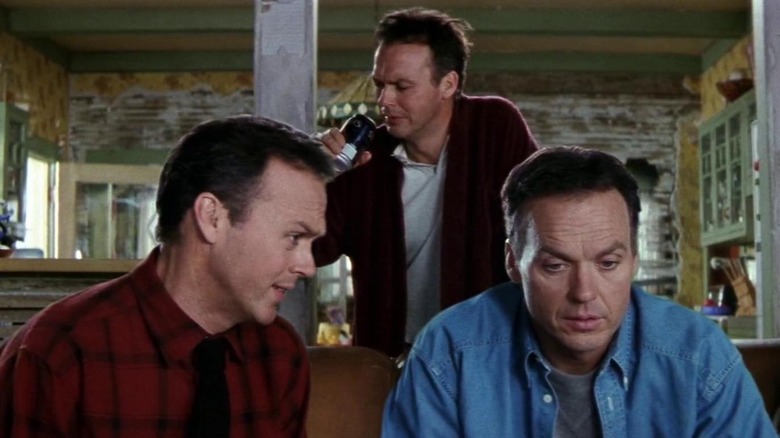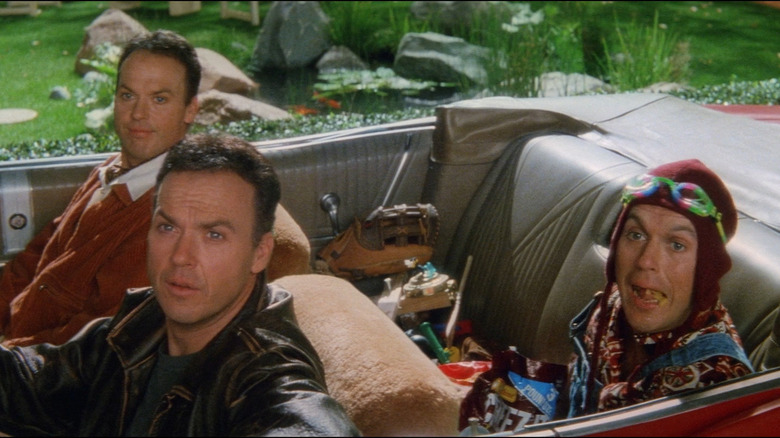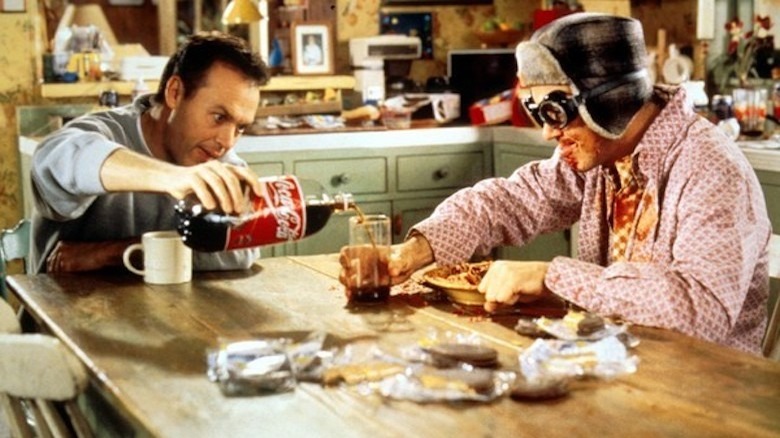How Harold Ramis Cloned Michael Keaton For Multiplicity
The term "movie magic" makes the art of filmmaking sound like intricate shots are as easy as the flick of a wand. But even in the age of CGI, some scenes can take an inordinate amount of planning. And can you imagine how much more difficult it was to pull off things like realistic dinosaurs, exploding spaceships, or twisters before advanced cinematic technology existed?
This isn't about to turn into a "back in my day" diatribe about how "kids have it so easy these days." Instead, it's more worthwhile to look back on movies that were released prior to the rise of computer-generated effects and truly appreciate the amount of work that went into creating them. For example, just how did Harold Ramis manage to "clone" Michael Keaton for "Multiplicity"?
The 1996 comedy about a man duplicating himself in order to create a better work-life balance for himself was hardly the first movie about clones or to feature a single actor playing multiple parts in the same scene. While "The Parent Trap" starring Hayley Mills may come to mind, Georges Méliès created a short film in 1898 where a magician interacted with four versions of his head in the same shot. The "A Trip to the Moon" filmmaker pulled it off by creating matte shots, a precursor to greenscreen that involved blocking parts of the camera lens and combining two strips of film into one.
While Ramis didn't use the exact same techniques as Méliès, the writer/director known for "Ghostbusters," "Groundhog Day," and "Caddyshack" used many of the same principles pioneered by the masters that came before him over the course of nearly 100 years.
Wherever the road takes us
While speaking to the Los Angeles Daily News in 1996 about his then-recent film, Ramis detailed how he and his crew managed to turn one Keaton into four Doug Kinneys. Similar to "The Parent Trap," they utilized stand-ins and shot the scene twice. However, to make things easier for their leading man who had to play off of himself, the director went one step further. He explained, "Michael would play each role against actor stand-ins, who would videotape him and then hold monitors of his performance when he played the next character." But then when a scene would require more than one Doug to interact, that's when they would bring in the green screen to create a seamless composite shot. Ramis continued:
"Whenever a character or a part of a character would pass around or in front of another, we'd shoot it against a green screen. The biggest shots like that were the ones in which Doug and Two bump chests, and when all three clones are shaving at the same time while being reflected in a bathroom mirror. For Michael to high-five himself, take a thermometer out of a clone's mouth or what have you, it would be the stand-in's arm, wearing the same shirt. Then we'd shoot it again with Michael replacing the stand-in and moving his torso as if he was moving his own arm."
I'd like to buy the world a Coke
With the evolution of green screen technology, Ramis had a far easier time than Méliès or any of the other silent movie era filmmakers that tried their hand at this particular illusion, especially when you can digitally attach a body double's arm to Michael Keaton's body to make a scene look more believable. Although, it wasn't as easy for Keaton when it came to something as simple as pouring a drink. Not only did the performer need to precisely recreate his movements in the scene, but he also had to match the flow of the liquid as he poured so it synced up with the other shots. Ramis recounted just how insane the process was for his actor:
"There is a scene where Doug pours Coca-Cola into a glass held by Four. He not only had to match the duration of the pouring that his stand-in had done, but he had to line up the stream of liquid and pour the right amount of it exactly. Those takes drove him nuts, because he couldn't look at a monitor for guidance. He reached a point of despair where he felt he could never do it, then inevitably got it on the next take."
It's a good thing that the actor persisted because his tedious work paid off. Now, "Multiplicity" stands as a testament to the fact that movie magic doesn't just happen with the snap of a director's fingers. Also, kids that make movies have it so easy these days.


